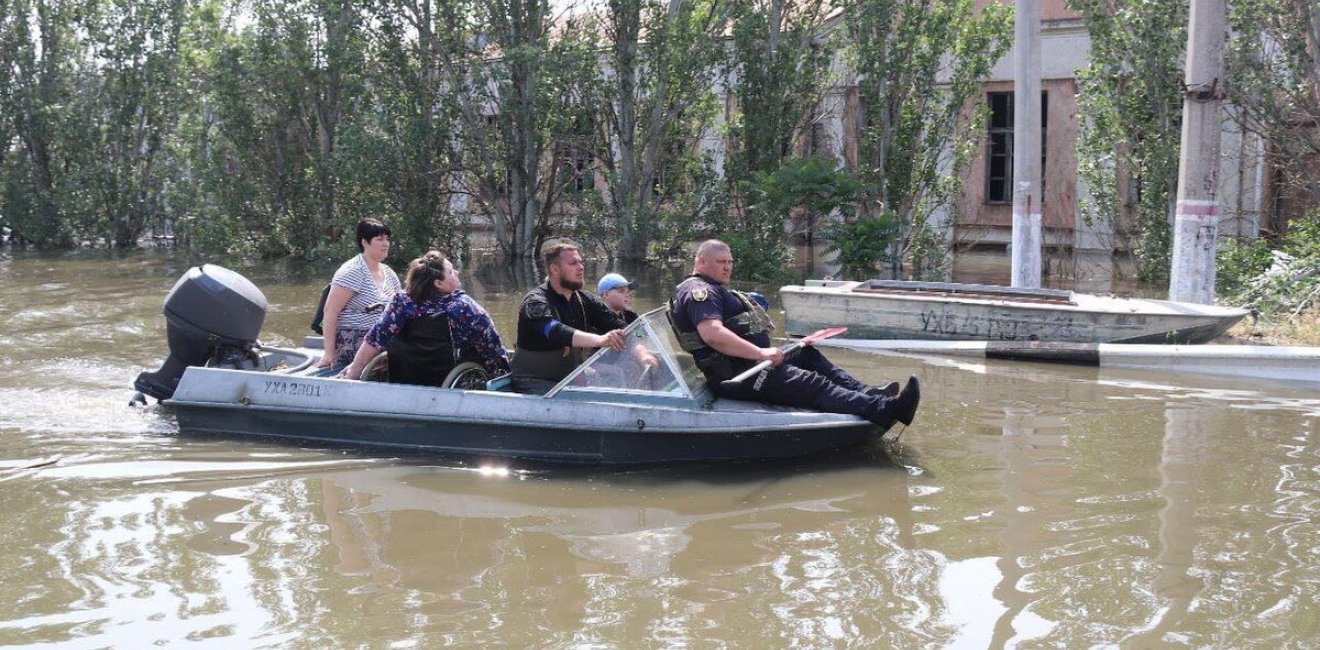
A blog of the Kennan Institute
The June 6 destruction of the Kakhovka dam by the Russian occupiers was a catastrophe not only for Ukraine but for the entire Eurasian region. What are the consequences of one of the worst human-caused disasters of our time for the region's residents and the environment?
Tracking the Path of the Water
When the previously mined dam in Nova Kakhovka, Kherson oblast, was breached on Tuesday, June 6, the waters released from the huge Kakhovka reservoir rushed downstream, flooding Oleshky, Kardashinka, Gola Prystan, and other villages along the left bank of the Dnipro river. On Wednesday, June 7, the floodwaters reached Kherson city, forcing residents to abandon their homes. Later, the water flowed into small rivers to the West of Dnipro and began to flood remote settlements far from the Kakhovka reservoir. This is how, for instance, small villages along the Ingulets in Mykolaiv oblast became inundated.
At the same time, in the wake of the massive water exodus, river levels south of Zaporizhzhia, above the dam, dropped, exposing the riverbed. A massive fish die-off ensued, and rescuers found unexploded shells from missiles that Russia had earlier launched toward Zaporizhzhia and Dnipro city. Some number of landmines have also been dislodged by the floodwaters and swept downstream, where their locations can no longer be tracked.
The collapse of the dam reduced the volume of water available to the North Crimean Canal, the main source of freshwater to the Russian-occupied Crimean Peninsula. The water level in the reservoir has dropped below the intake level, and water will soon stop flowing to occupied Crimea. The destruction of the hydroelectric power plant has also reduced the freshwater supply in the southern part of Kherson oblast and northern Crimea.
Official figures indicate that the Kakhovka reservoir has lost more than 72 percent of its former store of water. In the southern regions, local authorities have urged residents to limit water consumption because the dam had fed water to the reservoirs in these regions. For example, in Kryvyi Rih, one of the biggest industrial cities in Ukraine, a large part of the city may be left without water for the next month.
The Ruination of the People
Though residents of Ukraine were immediately informed of the dam’s collapse, many were unaware of the potential for massive flooding or did not think it would reach the scale it did. For example, in the village of Vasylivka in Mikolaiv oblast, which is located along the Ingulets River, a fifty-three-year-old man did not leave his house for a safer place because he thought nothing would happen; he went to bed and drowned. The leader of the local community (starosta) told me that because people did not believe that the dam breach in Nova Kakhovka would lead to flooding far beyond the Dnipro river, many lost all their belongings. Clothes, furniture, household appliances—everything was ruined by water.
Dozens of people are currently missing, both on the Russian-occupied left bank and in Ukrainian-controlled towns and villages on the right bank. The sudden surge of water caught many people by surprise, and they were unable to escape. Agricultural animals and domestic pets trapped in the flood zone without an escape route also died. However, rescuers and volunteers were able to evacuate more than 4,000 people, according to official figures from the Ukrainian emergency services.
As of June 14, more than 3,100 homes remained under water. Most of them will probably be uninhabitable when the water finally recedes. Many houses in the villages of Kherson and Mykolaiv oblasts are built of brick and clay, and the walls are literally disintegrating as they become waterlogged.
External Humanitarian Aid Slow to Arrive and Misdirected
As soon as the dam breach and water spill were recognized, hundreds of Ukrainian NGOs, volunteer groups, and prominent figures began collecting money and organizing humanitarian relief for the affected areas. First and foremost, they provided boats for rescuers, drinking water, and clothing. Many went to Kherson to help in the evacuation of residents and pets.
My sources in some large international organizations tell me that the international heavyweights, like the UN or the International Red Cross, were unable to respond quickly to the people’s needs. According to my informants, the problem of too little, too late from the largest aid deliverers is unchanged from the beginning of the invasion (see the Focus Ukraine blog post, “We Need People Who Are Focused on the Mission, Not on Rules and Procedures”). However, the UN stated that it had redoubled efforts to help Ukrainians in the affected areas and had been delivering water, food and cash to people affected by floods in Kherson and Mykolaiv oblasts in partnership with the local authorities since the first day of this disaster.
At the same time, most of the early international aid went to Kherson, the regional center. Much less humanitarian aid and volunteer support went to remote settlements and districts in the flooded areas, many of which have lost road connections that would allow residents to leave.
According to Lilia Bozhesku, executive director of the Bright Deeds Foundation, the largest local charitable foundation in Mykolaiv, which has been collecting and delivering humanitarian aid throughout the region from the start of Russia's invasion, international support has dropped significantly over the past few months. The difference is noticeable. In the summer of 2022, when Kherson was still occupied, the foundation's warehouses were overflowing with goods and products, and most of the prominent international organizations were among the donors. Now many shelves are empty, and the humanitarian aid is sponsored mostly by Ukrainian citizens.
Environmental Costs
The Kakhovka dam collapse is being called a new Chernobyl. It's not just a metaphor. This is one of the biggest human-caused disasters of our time. Drought, pollution, and unusable agricultural lands are just some of the costs of a degraded environment.
Agricultural Sector. The loss of the Kakhovka Hydroelectric Power Plant means that more than one million hectares of land in three southern oblasts of Ukraine—Kherson, Zaporizhzhia and Dnipropetrovsk oblasts—will be unusable for the next three to five years for lack of a water supply. Environmentalists predict that over the next twenty years, this will have a critical impact on the agricultural sector: farmland in the South will dry up and reclamation systems will be damaged without water.
Before the Kakhovka Reservoir and the reclamation system were created, most of Kherson and Zaporizhzhia was arid land. These oblasts were settled over the past 150–200 years, following the introduction of new crop cultivation technologies that permitted successful irrigation. The reclamation system helped spread the cultivation of grain crops—wheat, corn, rye, and sunflowers.
Without artificial irrigation from the Kaniv Reservoir on the Dnipro in Cherkasy and Kyiv oblasts, however, the entire agricultural industry would collapse, Vitalii Selyk, an energy history expert, said in an interview with the Ukrainian media outlet Zaborona. In the summer months, when the Dnipro is low, it will be impossible to provide water to the entire southern region, and the agricultural sector will lose a significant amount of grain and other crops.
Selyk also says that Ukraine is not in danger of famine as before the start of the full-scale war, the country held a record for grain production and harvested about 50 million tons, while the domestic need was 20 million tons. However, the problem of drought in southern Ukraine threatens the food security of African and Asian countries reliant on Ukrainian exports. The Kakhovka dam disaster could lead to higher grain prices, food shortages on world markets, and possibly famine in poorer countries. This is happening in the context of the existing grain crisis caused by Russia's blocking the Black Sea trade routes and stealing grain from Ukrainian territories.
Mass-Scale Pollution. According to the ecologist Oleh Lystopad, during the flooding, a lot of waste would likely have been washed toward and into the Black Sea. Such a large amount of organic pollution will significantly degrade water quality. It is already known that at least 150 tons of machine oil have leaked into the Dnipro, and there is a risk of further leakage of more than 300 tons. According to Lystopad, all the wells in the flooded area will be unusable even after the water recedes. Another problem is that not all farm animals have been evacuated, and their corpses could pose an epidemic threat. In addition, the steppe areas where many rare Red Data Book animals live are flooded. Most likely the world has already lost a large number of rare animals as a result of the flood.
Desertification. Experts also say that the destruction of the dam will affect the drainage of the Dnipro riverbed, which contains a huge amount of sand, with possible consequences including sandstorms, accelerated climate change, and potential desertification of neighboring regions. These effects are most likely to be felt in Kherson, Zaporizhzhia, Dnipro, and Donetsk oblasts, where they will add to the largest desert in Europe, the Oleshky Sands, located inland from the Black Sea.
Because of the enormous consequences for the environment of the dam breach, a partial rehabilitation of nature is one of the key tasks for the coming years. Complete rehabilitation is not envisioned. A comprehensive treatment of the South will require the efforts of possibly hundreds of specialists from around the world and, critically, the deoccupation of the territories captured by Russia.
The opinions expressed in this article are those solely of the author and do not reflect the views of the Kennan Institute.
Author


Kennan Institute
The Kennan Institute is the premier US center for advanced research on Eurasia and the oldest and largest regional program at the Woodrow Wilson International Center for Scholars. The Kennan Institute is committed to improving American understanding of Russia, Ukraine, Central Asia, the South Caucasus, and the surrounding region through research and exchange. Read more

Explore More in Focus Ukraine
Browse Focus Ukraine
Talking to the Dead to Heal the Living

Ukrainian Issue in Polish Elections


